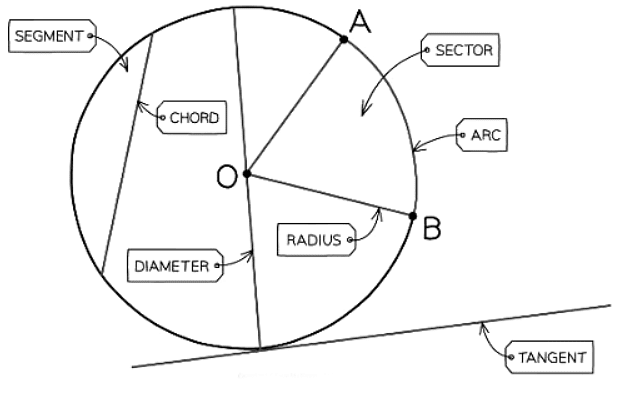Class 10 Exam > Class 10 Notes > Mathematics for GCSE/IGCSE > 2D Shapes
2D Shapes | Mathematics for GCSE/IGCSE - Class 10 PDF Download
Properties of 2D Shapes
You should recall the names and characteristics of 2D shapes, such as their equal sides and angles, how their diagonals intersect, the equality of angles, and the presence of lines of symmetry.
Which 2D shapes are important to know?
- Understand the basic names of all 2D polygons.
- A polygon is a flat shape on a plane with n straight sides.
- A triangle has 3 sides.
- A quadrilateral has 4 sides.
- A pentagon has 5 sides.
- A hexagon has 6 sides.
- A heptagon has 7 sides.
- An octagon has 8 sides.
- A nonagon has 9 sides.
- A decagon has 10 sides.

- Familiarize yourself with the names and characteristics of various types of triangles.
- An equilateral triangle has three equal sides and three equal angles.
- An isosceles triangle features two equal sides and two equal angles.
- A right triangle contains one angle measuring 90°.
- Understand the names and properties of different types of quadrilaterals.
- These include squares, rectangles, parallelograms, rhombuses, trapeziums, and kites.
- Learn about circles and their components.
- Understand their names and properties.
Properties of rectangles and squares
- Rectangles and squares both feature four equal right angles, each measuring 90°.
- Rectangles possess two pairs of equal, parallel sides.
- Squares, being a special type of rectangle, have all four sides equal in length.
- The diagonals of a rectangle intersect and bisect each other at the center, meaning they cut each other in half.
- At the intersection point, there are two pairs of angles: one pair of obtuse angles and one pair of acute angles for a rectangle, whereas all four angles in a square are 90°.
- Pythagoras’ theorem can be applied to determine the length of the diagonal in a square or rectangle.

Properties of parallelograms and rhombuses
- Parallelograms and rhombuses share the feature of having two pairs of equal, opposite angles.
- Both parallelograms and rhombuses possess two pairs of opposite, parallel sides.
- Rhombuses are distinguished by having four sides of equal length.
- While rhombuses are a type of parallelogram, they aren't regular because their angles aren't all equal.
- A square is essentially a regular rhombus.
- While rhombuses are a type of parallelogram, they aren't regular because their angles aren't all equal.
- The diagonals of a parallelogram intersect and bisect each other, forming two pairs of opposite angles.
- The diagonals of a rhombus intersect at right angles (90°), dividing each other into halves.
- Consequently, the diagonals are not of equal length.

Properties of trapeziums
- Trapeziums possess one pair of opposite, parallel sides, which are not equal in length.
- Trapeziums may lack any equal angles.
- Similar to all quadrilaterals, the sum of angles in a trapezium equals 360°.
- If a trapezium possesses a line of symmetry, it is categorized as isosceles.
- Isosceles trapeziums feature two pairs of equal angles.
- The non-parallel sides of an isosceles trapezium are of equal length.
- Isosceles trapeziums have two diagonals of equal length.

Properties of kites
- Kites possess one line of symmetry, referred to as their main diagonal.
- The angles opposite the main diagonal in kites are equal.
- The diagonals of a kite intersect and bisect each other at right angles (90°), dividing them in half.
- The diagonals of a kite are of unequal length.
- Kites lack parallel sides.
- Kites feature two pairs of equal, adjacent sides.

Properties of circles
- Circles stand apart from other 2D shapes, and understanding their specific terminology is crucial.
- In a circle, the boundary is termed as the circumference, while its line of symmetry is referred to as the diameter.
- The ratio circumference/diameter is equal to π.
- Circles exhibit various angle properties, detailed in Section 3.4 on Circle Theorems.

The document 2D Shapes | Mathematics for GCSE/IGCSE - Class 10 is a part of the Class 10 Course Mathematics for GCSE/IGCSE.
All you need of Class 10 at this link: Class 10
|
109 videos|689 docs|60 tests
|
FAQs on 2D Shapes - Mathematics for GCSE/IGCSE - Class 10
| 1. What are some properties of rectangles and squares? |  |
Ans. Rectangles have four right angles and opposite sides that are equal in length. Squares are a special type of rectangle where all sides are equal in length and all angles are right angles.
| 2. How are parallelograms and rhombuses different? |  |
Ans. A parallelogram has opposite sides that are parallel and equal in length, while a rhombus has all sides equal in length. Additionally, a rhombus has opposite angles that are equal.
| 3. What are some key properties of trapeziums? |  |
Ans. Trapeziums have one pair of parallel sides. The angles on the same side of the trapezium add up to 180 degrees. The bases of a trapezium are the parallel sides, and the height is the distance between the bases.
| 4. Can a rectangle also be a square? |  |
Ans. Yes, a square is a special type of rectangle where all sides are equal in length. Therefore, a square can also be considered a rectangle.
| 5. How can you identify an isosceles trapezium? |  |
Ans. An isosceles trapezium has a pair of equal non-parallel sides. This means that the base angles opposite the equal sides are also equal in measure.
Related Searches















